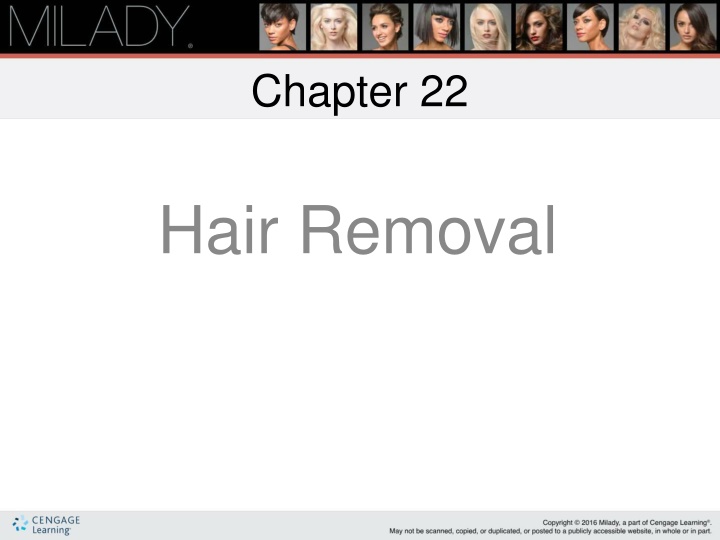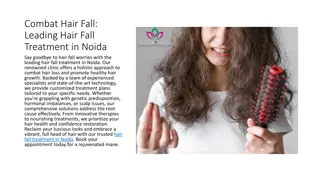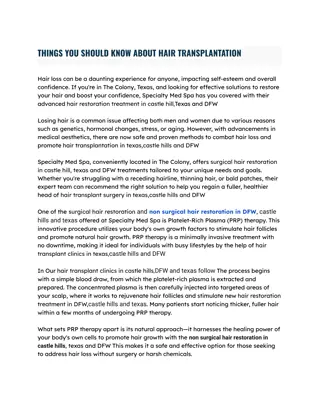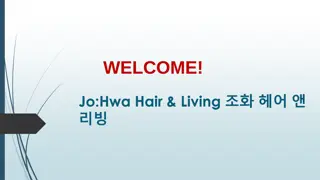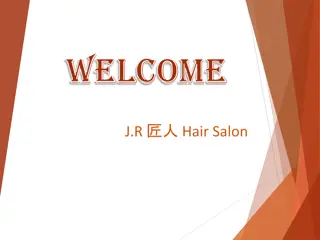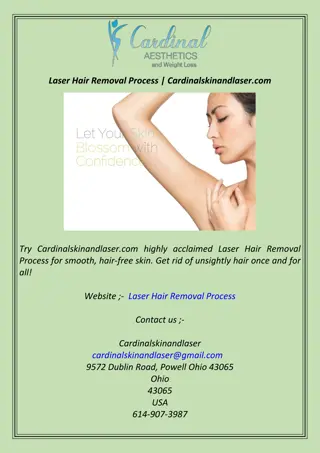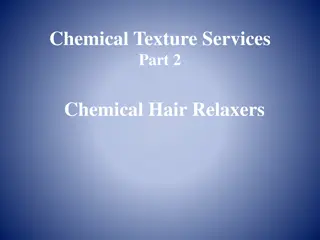Hair Removal
This content delves into the significance of client intake forms and contraindications in hair removal services, discussing methods for both permanent and temporary hair removal. It also covers the popularity of body waxing, conditions affecting hair removal, and key considerations for client consultations.
Uploaded on Feb 23, 2025 | 0 Views
Download Presentation

Please find below an Image/Link to download the presentation.
The content on the website is provided AS IS for your information and personal use only. It may not be sold, licensed, or shared on other websites without obtaining consent from the author.If you encounter any issues during the download, it is possible that the publisher has removed the file from their server.
You are allowed to download the files provided on this website for personal or commercial use, subject to the condition that they are used lawfully. All files are the property of their respective owners.
The content on the website is provided AS IS for your information and personal use only. It may not be sold, licensed, or shared on other websites without obtaining consent from the author.
E N D
Presentation Transcript
Chapter 22 Hair Removal
Learning Objectives Explain the significance of a client intake form used in hair removal services. Name the conditions that contraindicate hair removal in the salon. Identify and describe three methods of permanent hair removal. List the eight methods used for temporary hair removal.
Introduction Body waxing has gained a tremendous amount of popularity in the last few years. Hirsuties the growth of an unusual amount of hair on parts of the body normally bearing only downy hair, such as the faces of women and the backs of men. Hirsutism an excessive growth or cover of hair, especially in women. (continues)
Introduction (continued) The most common form of hair removal in salons and spas is waxing, but with the popularity of these services on the rise, many different methods are now coming into play. Many men are now frequently requesting hair removal services. The nape of the neck, chest, and back are the most frequent removal requests for men.
Consult the Client Disclosure of topical and oral medications Disclosure of medical issues Disclosure of skin disorders or allergies
Contraindications for Hair Removal Accutane Blood thinners Chemotherapy Autoimmune diseases Prednisone or steroids Skin diseases (continues)
Contraindications for Hair Removal (continued) Skin lesions Sunburn Cosmetic surgery Laser skin treatment Varicose veins Bleeding disorders Other questionable conditions
Describe Permanent Hair Removal Electrolysis electric current destroys the growth cells of the hair Photoepilation uses intense light to destroy the growth cells of the hair follicles Laser hair removal another method for the rapid removal of unwanted hair
Electrolysis Current applied with fine electrode Can be painful, time-consuming, expensive Requires special license
Photoepilation Also known as Intense Pulsed Light (IPL) Minimal side effects Requires no needles (reduced risk) Clears 50 to 60 percent of hair in 12 weeks Requires license
Laser Hair Removal Rapid removal Best in anagen phase Best response from coarse, dark hair Requires specialized training
Discuss Temporary Hair Removal Shaving Tweezing Depilatories Epilators Threading Sugaring
Shaving Men s facial hair Women s legs and underarms Quick and convenient Can result in irritation, ingrown hairs, and nicks from the blade
Tweezing Tweezing used to shape eyebrows and remove undesirable hairs around mouth and chin. The natural arch of the brow follows the orbital bone or the curved line of the eye socket. Consultation is used to avoid mistakes and ensure client satisfaction.
Depilatories Substances used for temporary removal of superfluous hair by dissolving at skin level Contain detergents Contain adhesives Expand hair, break disulfide bonds Require patch test
Epilators Wax (hot or cold) Applied to brows, cheeks, chin, upper lip, arms, and legs
Safety Precautions for Waxing Test wax temperature. Avoid wax contact with eyes. Never double-dip wax. Do not apply over warts, moles, abrasions, or irritated or inflamed skin. Use hard wax on sensitive skin. Apply aloe gel to calm and soothe.
Threading Practiced in Eastern cultures. Involves manipulation of thread. Thread is twisted and rolled on skin surface. Hair is entwined and lifted from follicle. Specialized training is required.
Sugaring An epilatory treatment that produces the same results as hot or cold wax Uses thick, sugar-based paste Appropriate for sensitive skin Residue removed by dissolving with warm water
Summary and Review Depilation is removing hair at the skin line such as shaving and using chemical depilatories. Epilation is removing hair below the skin line such as tweezing, waxing, and electrolysis. As a licensed practitioner, you will be asked to remove unwanted hair, especially the eyebrows and facial hair. (continues)
Summary and Review (continued) If you should choose to specialize in esthetics, you will want to become proficient in other hair removal services as allowed by the regulatory agency in the state or province where you practice. It is extremely important to follow cleaning and disinfection guidelines when removing unwanted hair. Cleanse and dry the treatment area prior to treatment and apply a cooling antiseptic afterward. Follow all safety precautions to protect the client from skin irritation or inflammation.
Chapter Review Questions 1. What information should be entered on the intake form during the consultation? 2. What conditions, treatments, and medications contraindicate hair removal in the salon? 3. What are the two major types of hair removal? Give examples of each. (continues)
Chapter Review Questions (continued) 4. Define electrolysis, photoepilation, and laser removal. 5. Which hair removal techniques should not be performed in the salon without special training? 6. What is the difference between a depilatory and an epilator? (continues)
Chapter Review Questions (continued) 7. Why must a test patch be given before waxing? 8. List safety precautions that must be followed for soft and hard waxing. 9. Define threading and sugaring.
